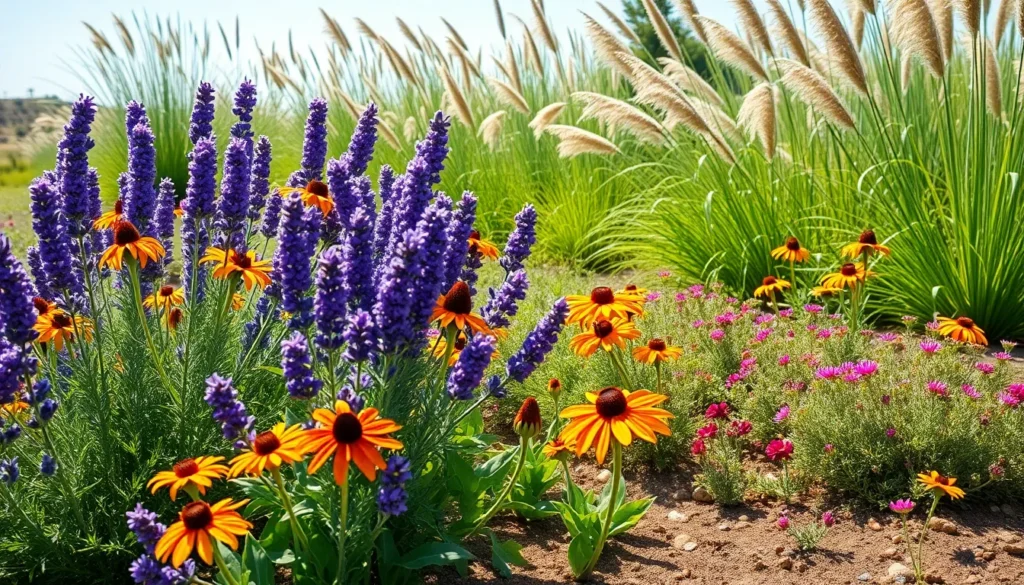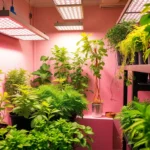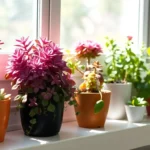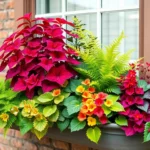We’ve all been there – staring at that sun-scorched corner of our yard wondering what could possibly survive the relentless heat and minimal water. Creating a thriving garden in challenging conditions doesn’t have to feel impossible when you choose the right plants.
Full sun drought tolerant plants offer the perfect solution for busy gardeners who want stunning landscapes without the constant watering schedule. These resilient beauties actually prefer neglect and reward us with vibrant blooms spectacular foliage and year-round interest even in the harshest conditions.
Whether you’re dealing with water restrictions looking to reduce maintenance or simply want plants that won’t wilt at the first sign of summer heat we’ll show you how to transform your challenging spaces into gorgeous low-maintenance gardens that thrive in full sun.
Best Perennial Full Sun Drought Tolerant Plants for Your Garden
Perennial drought tolerant plants offer the perfect solution for creating stunning gardens that thrive year after year with minimal water requirements. These hardy champions return each season stronger and more established than before.
Lavender: The Fragrant Mediterranean Classic
Lavender transforms any sunny garden space into an aromatic paradise while demanding almost no water once established. We’ve found that English lavender varieties like ‘Hidcote’ and ‘Munstead’ perform exceptionally well in zones 5-9, producing dense purple flower spikes from late spring through summer. French lavender varieties such as ‘Provence’ and ‘Grosso’ thrive in warmer climates and offer longer blooming periods.
Plant lavender in well-draining soil with a pH between 6.7 and 7.3 for optimal growth. Space plants 12-18 inches apart to ensure proper air circulation and prevent fungal issues. Harvest flower stems when about one-third of the buds have opened for the strongest fragrance and best drying results.
Full sun exposure for 6-8 hours daily maximizes essential oil production and flower development. Water deeply once weekly during the first growing season, then reduce to monthly watering in subsequent years. Prune stems back by one-third each spring to maintain compact growth and encourage new flowering shoots.
Black-Eyed Susan: Bright Yellow Blooms All Season
Black-eyed Susan delivers non-stop golden yellow flowers from midsummer through fall frost with virtually no maintenance required. We recommend ‘Goldsturm’ rudbeckia as our top choice because it produces 3-4 inch bright yellow blooms with dark chocolate centers on sturdy 24-inch stems.
Native to North America, these perennials adapt to poor soils and extreme heat better than most flowering plants. Deadhead spent blooms weekly to encourage continuous flowering, or leave seed heads intact in fall to provide winter food for goldfinches and other songbirds. Divide clumps every 3-4 years in early spring to maintain vigor and prevent overcrowding.
Direct sow seeds in spring after soil temperatures reach 70°F, or transplant nursery plants 18-24 inches apart. Water regularly during establishment, then reduce to supplemental watering only during extended dry periods exceeding 2-3 weeks.
Sedum: Succulent Beauty With Minimal Care
Sedum varieties offer incredible diversity in height, color, and bloom time while storing water in their thick fleshy leaves. We’ve had excellent success with ‘Autumn Joy’ sedum, which grows 18-24 inches tall and produces pink flower clusters that deepen to rust red by fall. ‘Dragon’s Blood’ sedum creates a stunning red carpet groundcover that spreads 12-18 inches wide.
These succulent perennials tolerate poor sandy or rocky soils that drain quickly after rainfall or irrigation. Plant sedum varieties 6-12 inches apart depending on mature size, and avoid overwatering which causes root rot and weak growth. Tall varieties may require staking in rich soils where they grow too quickly and become top heavy.
Propagate sedum easily by taking 3-4 inch stem cuttings in late spring or early summer. Allow cuttings to dry for 24-48 hours before planting in well-draining potting mix. Most sedum varieties multiply rapidly through underground runners and self-seeding, creating natural colonies within 2-3 growing seasons.
Top Annual Full Sun Drought Tolerant Plants for Continuous Color
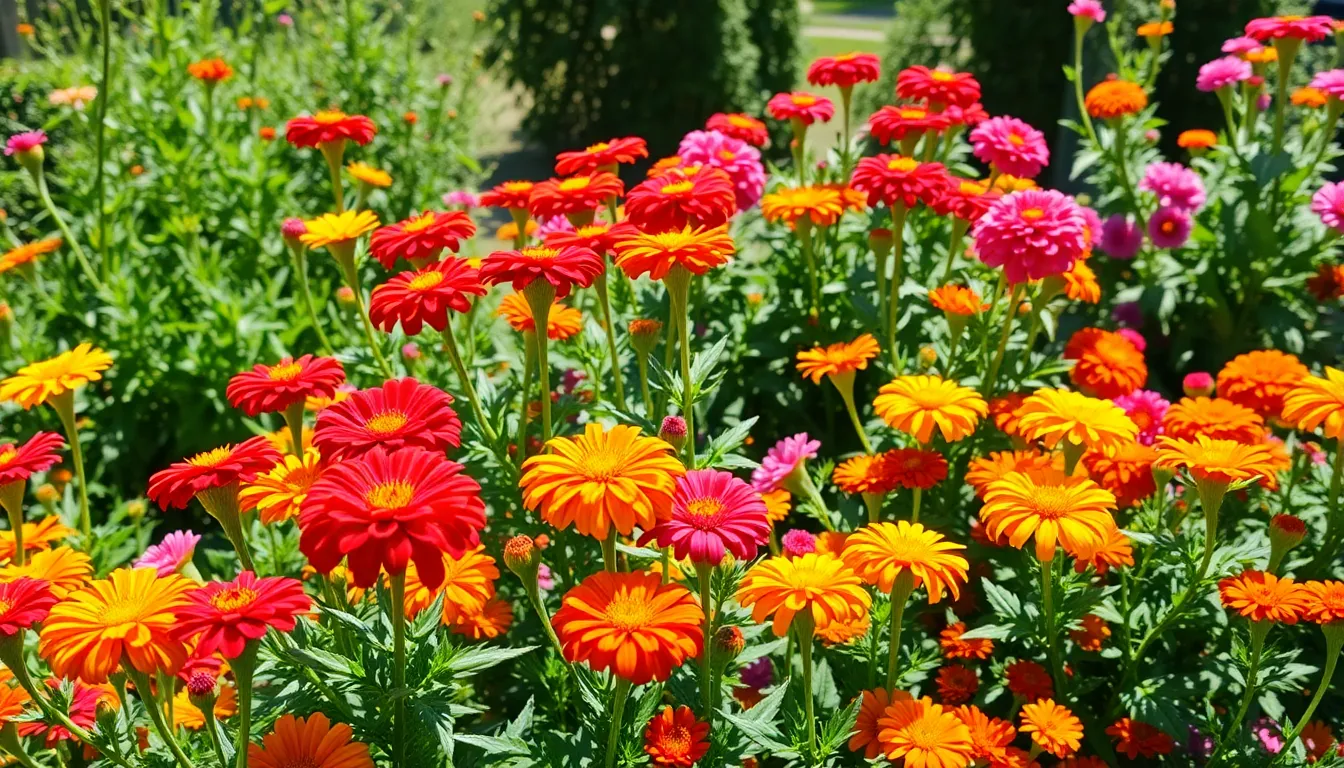
We’ll help you discover the best annual plants that deliver vibrant blooms all season long while requiring minimal water. These resilient varieties complement our perennial recommendations perfectly for a complete drought resistant garden.
Zinnia: Vibrant Flowers From Spring to Frost
Zinnias provide continuous color from spring until the first frost with their bright, cheerful blooms. We recommend these heat loving flowers for their exceptional drought tolerance once established. Butterflies and bees flock to zinnia flowers, creating a pollinator friendly garden space.
Full sun conditions bring out the best in zinnias, which prefer well draining soil to prevent root rot. These versatile annuals offer an impressive range of bright colors including red, orange, yellow, pink, and purple. We’ve found that zinnias require minimal maintenance once they’re established in your garden.
Marigold: Hardy Blooms That Thrive in Heat
Marigolds excel in hot, sunny conditions while requiring very little water throughout the growing season. These hardy annuals produce abundant bright yellow, orange, and red flowers that bloom profusely through summer heat. We often use marigolds in companion planting for their natural pest control properties.
Full sun exposure maximizes marigold blooming potential, and they grow best in well drained soil conditions. Their robust nature makes them ideal for beginning gardeners or busy homeowners. We appreciate how marigolds maintain their vibrant appearance even during extended dry periods.
Portulaca: Ground Covering Succulent Flowers
Portulaca creates stunning ground cover with its fleshy water storing leaves and multicolored rose shaped flowers. Native to dry regions of Argentina and Brazil, this drought adapted semi succulent thrives where other plants struggle. We love how portulaca’s flowers open in bright sunlight and close at night.
Sandy or rocky soils provide perfect growing conditions for portulaca in full sun locations. This low growing plant reaches 3 to 8 inches in height with a 6 to 12 inch spread. We find portulaca particularly valuable for rock gardens and hot garden beds where extreme conditions challenge most plants.
Starting portulaca from seed proves easy whether you begin indoors early or sow directly outside after frost danger passes. Pollinator friendly flowers attract beneficial insects while requiring virtually no maintenance from busy gardeners.
Hardy Shrubs That Love Full Sun and Dry Conditions
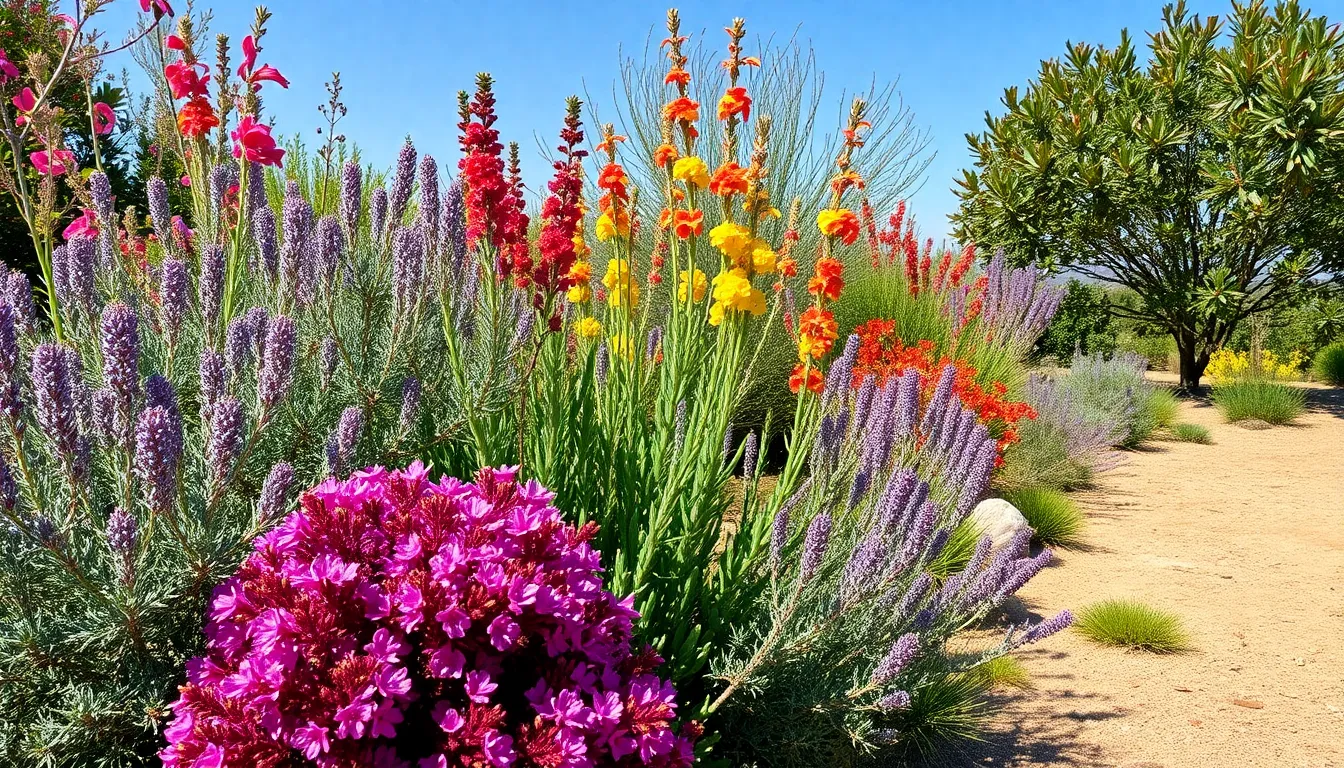
Building on our exploration of drought-tolerant perennials and annuals, we now turn to hardy shrubs that create lasting structure in challenging landscapes. These resilient woody plants establish permanent foundations for water-wise gardens while delivering year-round beauty.
Rosemary: Culinary Herb With Evergreen Appeal
Rosemary transforms any sunny garden space into both a culinary treasure and an aromatic industry feature. This evergreen shrub adapts perfectly to full sun conditions while requiring minimal water once its root system establishes. We recommend planting rosemary in well-drained soil where it can develop its characteristic needle-like leaves and woody stems that naturally conserve moisture.
Culinary benefits make rosemary an exceptional dual-purpose plant for our drought-tolerant gardens. Fresh sprigs enhance everything from roasted vegetables to grilled meats, providing year-round harvesting opportunities. Mediterranean varieties like ‘Tuscan Blue’ and ‘Hill Hardy’ offer the best combination of cold tolerance and drought resistance for challenging climates.
Xeriscaping projects benefit tremendously from rosemary’s structural presence and water-saving qualities. This fragrant shrub maintains its green appeal throughout all seasons, eliminating the need for seasonal replanting. Pruning after flowering keeps plants compact while encouraging bushier growth patterns that work well in border plantings or foundation landscapes.
Barberry: Thorny Beauty With Colorful Foliage
Barberry shrubs deliver striking color variations while thriving in the harshest full sun conditions. These hardy plants showcase foliage ranging from deep green to brilliant red and purple hues, creating dramatic focal points in water-wise landscapes. Thorny branches provide natural security features, making barberry excellent choices for property borders or defensive plantings.
Hedge applications showcase barberry’s versatility in challenging growing conditions. Once established, these shrubs require minimal irrigation while maintaining their dense, compact growth habit. We’ve found that varieties like ‘Crimson Pygmy’ and ‘Rose Glow’ offer the most reliable performance in drought-prone areas.
Border plantings benefit from barberry’s low maintenance requirements and consistent appearance. These resilient shrubs tolerate poor soils and extreme heat while providing four-season interest through their colorful foliage. Regular pruning in late winter maintains desired shapes without compromising the plant’s natural drought tolerance.
Russian Sage: Silver-Blue Spikes of Fragrance
Russian sage creates stunning textural contrasts with its silver-blue foliage and tall flower spikes. This aromatic shrub prefers full sun exposure and well-drained soil conditions, displaying exceptional drought tolerance once established. Blue flower spikes emerge in mid-summer, providing vertical interest that complements lower-growing drought-tolerant companions.
Pollinator attraction makes Russian sage valuable beyond its ornamental qualities. Bees and butterflies frequent the tubular blue flowers throughout the blooming season, supporting local ecosystems while requiring no supplemental watering. We recommend spacing plants 3-4 feet apart to allow proper air circulation and prevent moisture-related issues.
Xeriscape designs incorporate Russian sage as both a specimen plant and mass planting option. This versatile shrub adds fragrance when brushed against, releasing aromatic oils from its silvery leaves. Late-season pruning to 6-8 inches above ground level encourages vigorous spring growth while maintaining the plant’s drought-adapted characteristics.
Native Full Sun Drought Tolerant Plants for Eco-Friendly Landscaping
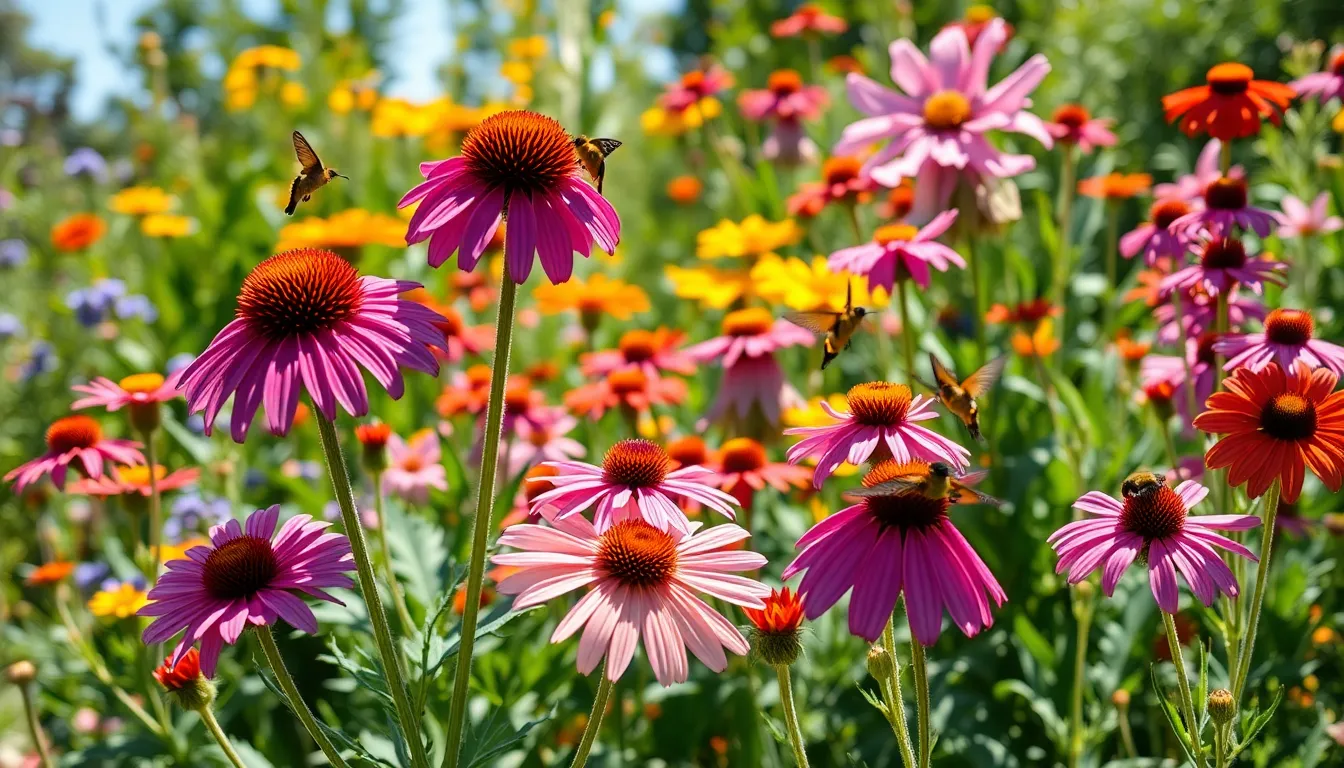
Native plants offer unmatched sustainability benefits while requiring minimal water and maintenance. We’ll explore three exceptional native species that transform challenging landscapes into thriving ecosystems.
Purple Coneflower: Wildlife Magnet With Healing Properties
Purple Coneflower (Echinacea purpurea) stands as North America’s premier prairie perennial, reaching impressive heights of 2 to 5 feet with striking daisy-like purple blooms. This upright spreading native thrives in full sun conditions and demonstrates remarkable tolerance to both heat and drought once established.
Wildlife enthusiasts appreciate how this maintenance-free perennial attracts butterflies and pollinators throughout its mid-summer to fall blooming period. Songbirds benefit from the nutritious seed heads that persist through winter months, creating year-round ecological value in our gardens.
Xeriscaping projects gain long-lasting color and virtually zero-maintenance requirements when we incorporate Purple Coneflower into prairie-style plantings. Traditional medicinal uses have made this native plant culturally important, though we primarily value its ornamental and ecological contributions today.
Blanket Flower: Cheerful Daisy-Like Blooms
Blanket Flower (Gaillardia spp.) produces vibrant daisy-like blooms in brilliant combinations of red, yellow, and orange hues that brighten any full sun location. This native wildflower prefers well-drained soil conditions and becomes highly drought tolerant once its root system establishes.
Pollinators including bees and butterflies flock to these cheerful flowers throughout the growing season. Dry, sunny garden beds and borders become focal points when we plant these resilient natives that continue blooming even though challenging conditions.
Low water requirements make Blanket Flower ideal for waterwise landscaping projects where consistent irrigation isn’t feasible. Gardeners appreciate how these natives maintain their vibrant appearance even during extended dry periods that stress less adapted plants.
Penstemon: Tubular Flowers That Attract Hummingbirds
Penstemon species, commonly called Beardtongue, showcase tubular flowers in diverse color ranges that specifically attract hummingbirds and beneficial insects. These drought-tolerant natives require full sun exposure and well-draining soil to reach their optimal performance levels.
Hummingbird populations benefit significantly from the nectar-rich flowers that bloom throughout much of the growing season. Rock gardens, slopes, and challenging dry sunny spots become productive habitat areas when we incorporate these specialized native plants.
Native landscaping projects gain vertical interest and wildlife support through strategic Penstemon placement in areas where other plants struggle. Water conservation efforts succeed when we choose these adapted natives that thrive without supplemental irrigation once established.
Ornamental Grasses Perfect for Sunny, Dry Areas
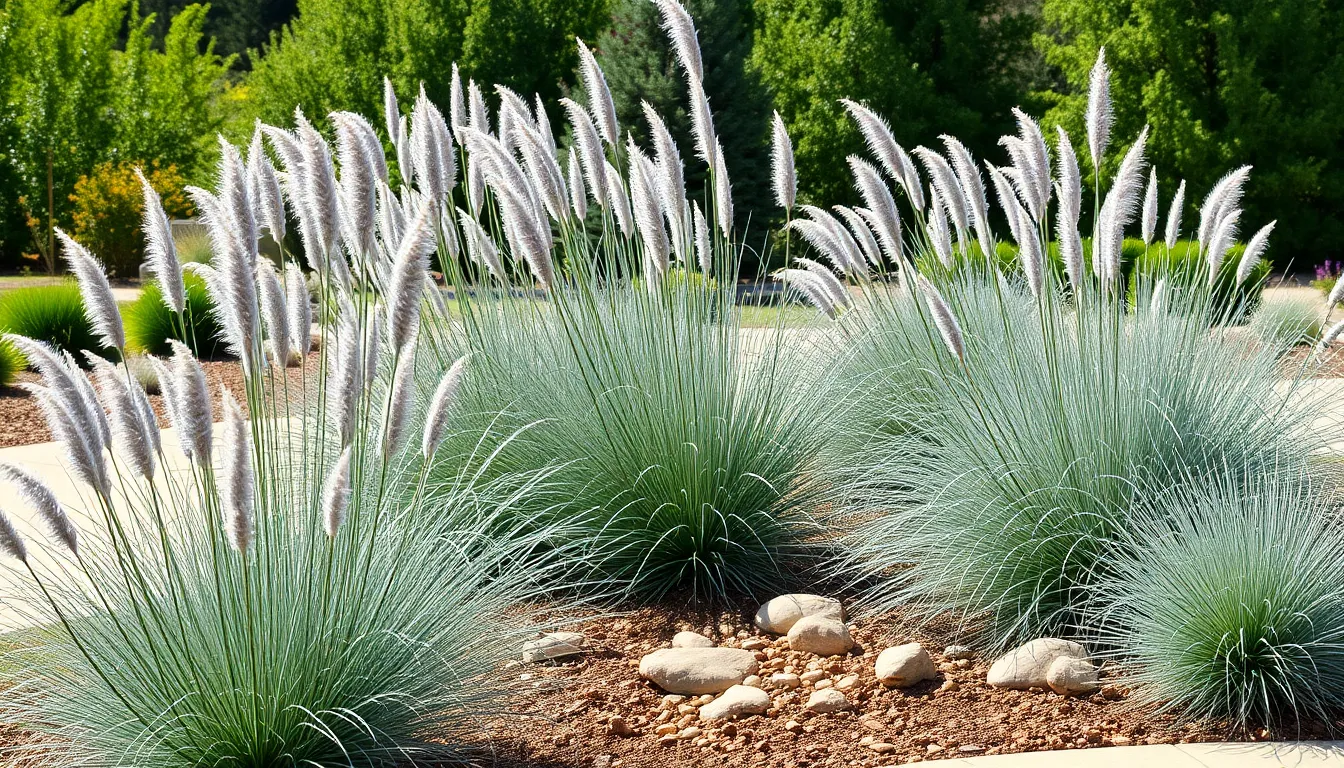
After exploring drought-tolerant perennials, annuals, shrubs, and native plants, ornamental grasses offer another exceptional option for creating texture and movement in challenging dry conditions. These versatile plants bring year-round structure to our landscapes while requiring minimal water once established.
Blue Fescue: Compact Clumps of Blue-Gray Texture
Blue Fescue forms distinctive rounded clumps with fine-textured, blue-gray foliage that creates stunning color contrast in our garden beds. We’ll find this compact grass thrives in full sun and well-drained soils, showing excellent drought tolerance once its roots develop. Its low maintenance nature makes it perfect for busy gardeners who want reliable texture without constant care.
Container planting becomes effortless with Blue Fescue’s compact size, allowing us to add striking accents to patios and walkways. Rock gardens benefit tremendously from its unique blue-gray coloration, which complements stone features beautifully. Border plantings gain sophisticated texture when we incorporate these neat, rounded clumps along pathways or garden edges.
Fountain Grass: Graceful Plumes That Sway in Breeze
Fountain Grass produces graceful, arching plumes that create beautiful movement as they sway naturally in the wind. Full sun exposure suits this grass perfectly, and it tolerates drought exceptionally well in well-drained soils. Hot, dry climates don’t phase this resilient grass, making it ideal for challenging southwestern gardens.
Texture and movement come together when we plant Fountain Grass as focal points in our drought-tolerant designs. Complementary plantings work wonderfully when we pair it with other sun-loving drought-tolerant plants like lavender or sedum. Industry appeal increases dramatically as these elegant plumes catch light and create ever-changing visual interest throughout the seasons.
Buffalo Grass: Low-Maintenance Lawn Alternative
Buffalo Grass serves as an excellent native, warm-season lawn alternative that requires minimal maintenance compared to traditional turf. Full sun requirements align perfectly with its highly drought-tolerant nature, needing minimal irrigation after establishment. Fine-textured, dense turf forms naturally, creating an attractive ground cover that withstands extreme heat and dry conditions.
Water-wise landscaping becomes achievable when we choose Buffalo Grass for large areas traditionally covered by thirsty lawn grass. Mowing needs decrease significantly compared to conventional turf, reducing both maintenance time and costs. Sustainable gardening practices improve when we incorporate this native grass that supports local ecosystems while conserving precious water resources.
Succulent Full Sun Drought Tolerant Plants for Modern Gardens
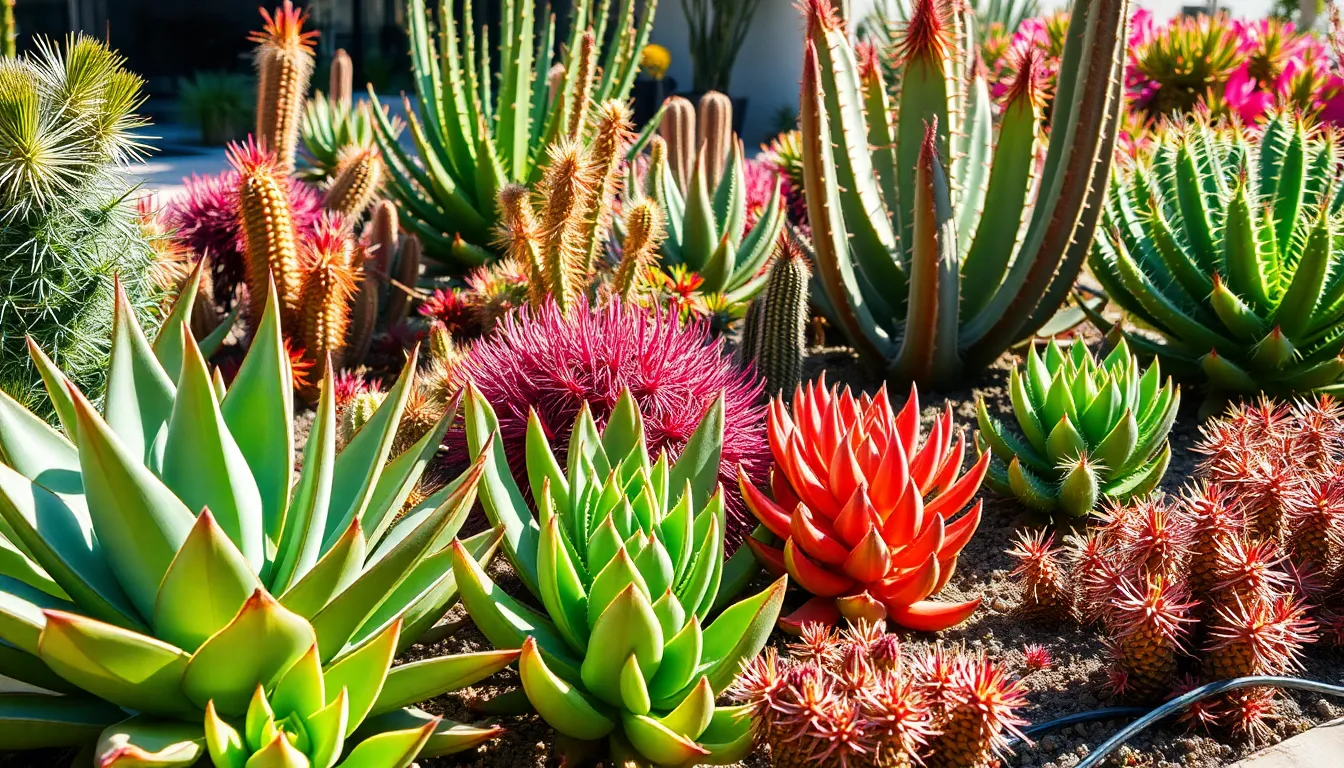
Succulents offer the perfect combination of architectural beauty and water-wise gardening for modern landscapes. These remarkable plants store water in their thick, fleshy leaves, making them ideal for full sun conditions where traditional plants struggle.
Agave: Architectural Rosettes With Striking Form
Agave plants create bold, dramatic focal points with their sculptural rosette shape that commands attention in any garden design. These water-storing succulents thrive in full sun conditions and require minimal irrigation once established in your industry. Their thick, fleshy leaves act as natural reservoirs, allowing them to survive extended dry periods without compromising their striking appearance.
We recommend planting agaves in well-draining soil where water doesn’t collect, as they prefer dry conditions over soggy ground. Their architectural form makes them perfect for creating dramatic centerpieces in modern garden designs. Low maintenance requirements mean you’ll spend less time watering and more time enjoying their impressive presence in your drought-tolerant industry.
Prickly Pear Cactus: Desert Beauty With Edible Fruit
Prickly Pear Cactus (Opuntia spp.) brings desert elegance to your garden with its distinctive flat, paddle-shaped stems and vibrant blooms. This hardy succulent produces stunning yellow, red, or purple flowers that add seasonal color to your drought-tolerant industry. Native to arid regions, it’s perfectly adapted to hot, dry climates and thrives in full sun conditions.
Beyond ornamental value, this cactus produces edible fruit called “tunas” that you can harvest for culinary use. Well-draining soil is essential for optimal growth, making it an excellent choice for xeriscaping projects. Hot, dry climates don’t phase this resilient plant, as it’s naturally equipped to handle challenging conditions that would stress other garden plants.
Hens and Chicks: Spreading Rosettes That Multiply
Hens and Chicks (Sempervivum spp.) create natural ground cover through their unique spreading growth pattern that multiplies over time. These small, hardy succulents form charming rosettes that store water in their thick leaves, making them perfect for full sun and dry conditions. Cold-hardy characteristics allow them to survive harsh winters while maintaining their low-maintenance appeal.
Rock gardens, borders, and containers all benefit from the texture and interest these plants provide. Their spreading nature means you’ll get more plants naturally as they multiply, creating excellent value for your investment. Very low maintenance requirements make them ideal for busy gardeners who want beautiful results without constant attention to watering schedules.
Essential Care Tips for Full Sun Drought Tolerant Plants
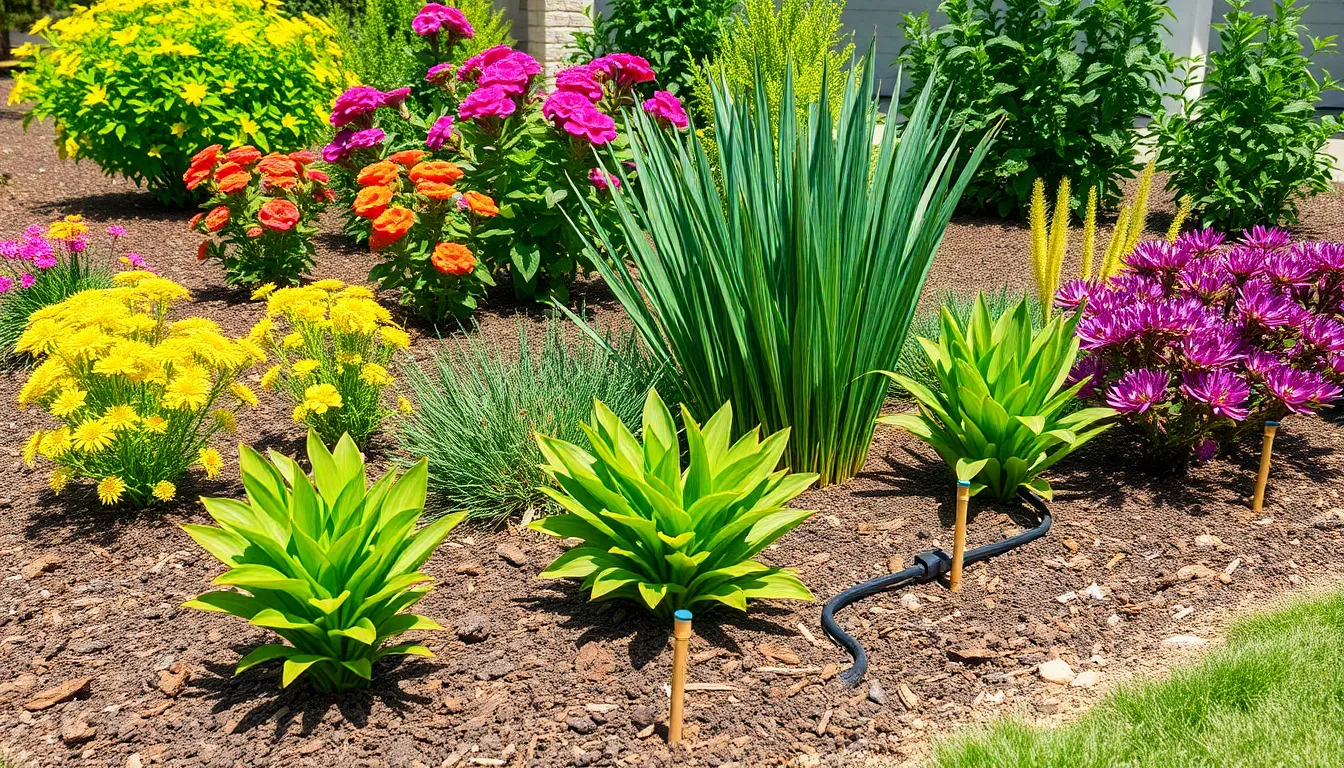
Success with drought tolerant plants begins with understanding their unique needs from planting through seasonal care. We’ll walk you through proven techniques that ensure your water wise garden thrives year after year.
Proper Planting Techniques for Success
Timing sets the foundation for drought tolerant plant success. We recommend planting these resilient species in early spring or fall when cooler temperatures reduce stress and improve establishment rates.
Soil preparation requires attention to drainage and pH levels before planting begins. Test your soil for nutrient content and pH to determine what amendments you’ll need for optimal growing conditions.
Amendment improves drainage and aeration in heavy soils that might waterlog your plants. We suggest adding coarse sand or gravel to clay soils to prevent root rot in drought adapted species.
Spacing follows exact recommendations for each plant variety to ensure proper air circulation and root expansion. Follow the guidelines for your chosen plants to avoid overcrowding that can lead to disease issues.
Depth matters significantly when installing drought tolerant plants in your garden. Plant at the same depth as the nursery container to avoid stem rot or root exposure problems.
Drip irrigation delivers water efficiently to newly planted specimens while conserving precious water resources. We recommend installing drip systems before planting to ensure consistent moisture delivery.
Watering Strategies During Establishment
Daily watering supports root development during the first week after planting drought tolerant varieties. We’ve found that newly planted specimens need consistent moisture to establish their root systems in their new environment.
Every other day watering continues through the second week as plants begin adapting to their new location. Monitor soil moisture levels closely during this critical establishment period.
Deep watering replaces frequent shallow irrigation once plants show signs of new growth after 2-3 weeks. We recommend soaking the soil thoroughly then allowing the top layer to dry between watering sessions.
Gradual reduction in frequency helps plants develop deeper root systems that access moisture from lower soil levels. Shift from daily watering to twice weekly then weekly as establishment progresses.
Soil drying between sessions prevents overwatering that can damage drought adapted plants more than underwatering. We check soil moisture by inserting our finger 2-3 inches deep before watering again.
Seasonal Maintenance Requirements
Regular monitoring prevents both underwatering and overwatering throughout the growing season. We check soil moisture weekly during hot weather and adjust irrigation accordingly.
Pruning and deadheading encourage healthy growth and continued flowering in many drought tolerant species. Remove spent flowers and trim damaged growth as needed based on your exact plant varieties.
Mulching conserves moisture and reduces evaporation around your established plants. We apply 2-3 inches of organic mulch around plants while keeping it away from stems to prevent rot.
Extreme weather adjustments become necessary during heatwaves or extended drought periods. Increase watering frequency during these conditions but maintain deep watering practices to avoid shallow root development.
Pest and disease management remains important even with hardy drought tolerant plants. We watch for stress related infestations and treat promptly with appropriate organic or chemical controls as needed.
Conclusion
Creating a stunning water-wise garden doesn’t require sacrificing beauty or variety. We’ve shown you how drought-tolerant plants can transform challenging spaces into thriving landscapes that conserve water while delivering year-round visual appeal.
These resilient plants prove that sustainable gardening is both practical and rewarding. From vibrant annuals to architectural succulents we’ve covered options that’ll work in any climate or garden style.
Start small with a few favorites from our recommendations and watch your confidence grow. Your garden will thank you with reduced maintenance needs lower water bills and the satisfaction of creating an eco-friendly outdoor space that flourishes even though challenging conditions.
Frequently Asked Questions
What are full sun drought-tolerant plants?
Full sun drought-tolerant plants are hardy species that thrive in direct sunlight for 6+ hours daily and require minimal water once established. These resilient plants have adapted to survive in hot, dry conditions through features like deep root systems, waxy leaves, or water-storing capabilities. They’re perfect for water-wise gardening and low-maintenance landscapes.
Which perennial drought-tolerant plants work best in full sun?
The top perennial choices include lavender, which offers fragrance and purple blooms; black-eyed Susan with vibrant yellow flowers; and sedum varieties that provide diverse textures and colors. These plants return year after year, require minimal care once established, and can withstand extreme heat while maintaining their beauty throughout the growing season.
What are the best drought-tolerant annual flowers for continuous color?
Zinnias, marigolds, and portulaca are excellent annual options for full sun drought conditions. Zinnias provide vibrant blooms from spring to frost, marigolds offer pest control benefits while thriving in heat, and portulaca excels as a low-growing succulent perfect for sandy or rocky soils with minimal water requirements.
Which shrubs are most drought-tolerant for full sun areas?
Rosemary serves as both a culinary herb and ornamental shrub, requiring minimal water while providing year-round structure. Barberry offers colorful foliage and thorny security features, while Russian sage produces striking silver-blue flower spikes that attract pollinators. All three create lasting landscape structure in challenging dry conditions.
What native plants work well in drought-tolerant gardens?
Purple Coneflower attracts wildlife and provides healing properties, Blanket Flower offers vibrant daisy-like blooms that attract pollinators, and Penstemon produces tubular flowers perfect for hummingbirds. These native species support local ecosystems while requiring minimal water and thriving in challenging sunny locations with poor soil conditions.
Are ornamental grasses good for drought-tolerant landscaping?
Yes, ornamental grasses excel in drought conditions while adding texture and movement. Blue Fescue forms compact blue-gray clumps, Fountain Grass creates graceful swaying plumes, and Buffalo Grass serves as a low-maintenance lawn alternative. These grasses require minimal irrigation once established and support sustainable gardening practices.
Which succulents thrive in full sun drought conditions?
Agave creates dramatic rosette-shaped centerpieces, Prickly Pear Cactus offers ornamental value plus edible fruit, and Hens and Chicks spread naturally as ground cover. These architectural succulents combine striking visual appeal with minimal water needs, making them perfect for modern water-wise garden designs in hot climates.
How should I care for drought-tolerant plants during establishment?
Plant in early spring or fall for best establishment. Ensure excellent drainage and water regularly during the first growing season to develop deep root systems. Use drip irrigation for efficient water delivery, apply mulch to retain moisture, and gradually reduce watering frequency as plants become established and self-sufficient.
When is the best time to plant drought-tolerant species?
Early spring or fall are optimal planting times when temperatures are moderate and natural rainfall helps establishment. Avoid planting during peak summer heat or winter freezes. Spring planting allows roots to develop before summer stress, while fall planting takes advantage of cooler temperatures and winter moisture for strong root development.
What soil conditions do drought-tolerant plants prefer?
Most drought-tolerant plants thrive in well-draining soil and can tolerate poor, sandy, or rocky conditions. Good drainage is essential to prevent root rot. Many species actually prefer lean soils over rich, fertile ground. Avoid heavy clay that retains water, and consider adding sand or gravel to improve drainage in problem areas.

